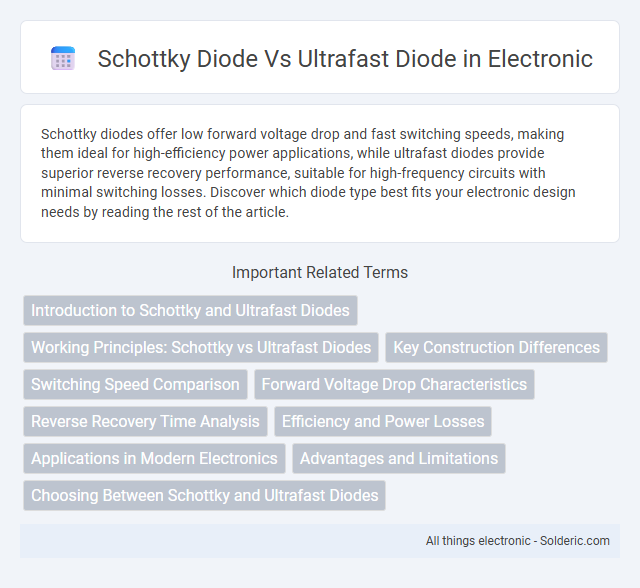Schottky diodes offer low forward voltage drop and fast switching speeds, making them ideal for high-efficiency power applications, while ultrafast diodes provide superior reverse recovery performance, suitable for high-frequency circuits with minimal switching losses. Discover which diode type best fits your electronic design needs by reading the rest of the article.
Comparison Table
| Feature | Schottky Diode | Ultrafast Diode |
|---|---|---|
| Switching Speed | Very fast (nanoseconds) | Extremely fast (picoseconds to nanoseconds) |
| Forward Voltage Drop | Low (0.15 - 0.45 V) | Moderate (0.7 - 1.0 V) |
| Recovery Time | Minimal reverse recovery | Fast reverse recovery (few nanoseconds) |
| Reverse Leakage Current | Higher leakage current | Lower leakage current compared to Schottky |
| Applications | Power rectifiers, RF circuits, low voltage power supplies | High-speed switching, switching power supplies, snubber circuits |
| Maximum Voltage | Typically low (< 100 V) | Higher voltage ratings (up to several hundred volts) |
Introduction to Schottky and Ultrafast Diodes
Schottky diodes are semiconductor devices known for their low forward voltage drop and fast switching speed, making them ideal for high-efficiency power applications and low-voltage circuits. Ultrafast diodes, on the other hand, are designed to switch at very high speeds with minimal reverse recovery time, which enhances performance in high-frequency rectification and switching power supplies. Choosing the right diode, whether Schottky or Ultrafast, depends on your circuit's speed, voltage, and efficiency requirements.
Working Principles: Schottky vs Ultrafast Diodes
Schottky diodes operate based on a metal-semiconductor junction, enabling low forward voltage drop and fast switching capabilities ideal for high-frequency applications. Ultrafast diodes utilize a pn-junction with optimized semiconductor material and doping profiles to achieve rapid recovery times and minimal reverse recovery charge, enhancing efficiency in high-speed rectification. Your choice between these diodes depends on balancing switching speed and forward voltage requirements in power electronics.
Key Construction Differences
Schottky diodes feature a metal-semiconductor junction that allows for low forward voltage drop and fast switching speeds, while ultrafast diodes use a p-n junction with optimized doping profiles to achieve rapid recovery times. The Schottky diode's construction eliminates minority carrier storage, enabling faster conduction without significant charge storage effects. In contrast, ultrafast diodes incorporate thin epitaxial layers and tailored doping to minimize reverse recovery time, balancing speed with higher voltage capabilities.
Switching Speed Comparison
Schottky diodes exhibit ultra-fast switching speeds due to their metal-semiconductor junction, typically switching in the nanosecond range, which reduces switching losses significantly in high-frequency applications. Ultrafast diodes, often based on PN junctions with optimized doping and geometry, switch faster than standard diodes but generally operate in the range of nanoseconds to a few tens of nanoseconds. The Schottky diode's lower forward voltage drop and minimal charge storage enable superior switching performance compared to ultrafast diodes in power conversion and RF circuits.
Forward Voltage Drop Characteristics
Schottky diodes exhibit lower forward voltage drop, typically around 0.2 to 0.3 volts, enhancing energy efficiency and reducing power loss in low-voltage applications. Ultrafast diodes, while having slightly higher forward voltage drops ranging from 0.3 to 0.7 volts, offer rapid recovery times suitable for high-frequency switching circuits. Understanding your application's voltage and speed requirements helps determine whether a Schottky diode's lower forward voltage drop or an ultrafast diode's switching performance is more advantageous.
Reverse Recovery Time Analysis
Schottky diodes exhibit significantly lower reverse recovery time compared to ultrafast diodes due to their majority carrier conduction mechanism, resulting in reduced switching losses and improved efficiency in high-frequency applications. Ultrafast diodes, while faster than standard diodes, still possess a reverse recovery charge that can cause increased power dissipation and electromagnetic interference. When selecting a diode for your circuit, focusing on reverse recovery time analysis can help optimize performance, especially in power electronics and switching circuits.
Efficiency and Power Losses
Schottky diodes exhibit lower forward voltage drop, resulting in higher efficiency and reduced power losses compared to ultrafast diodes, especially in low voltage, high-frequency applications. Ultrafast diodes provide faster recovery times but generally have higher forward voltage, causing increased conduction losses and lower overall efficiency. Your choice between the two depends on balancing switching speed requirements with the desire to minimize power dissipation in electronic circuits.
Applications in Modern Electronics
Schottky diodes find extensive use in high-speed switching power supplies and RF applications due to their low forward voltage drop and fast recovery time, enhancing energy efficiency and reducing power loss. Ultrafast diodes are preferred in high-frequency inverters, solar panel systems, and motor drives for their rapid switching capabilities that minimize switching losses and electromagnetic interference. Both diodes are crucial in modern electronics for improving performance in power conversion and signal rectification tasks.
Advantages and Limitations
Schottky diodes offer low forward voltage drop and fast switching speeds, making them ideal for high-efficiency power supplies and RF applications, but they have lower reverse voltage ratings and higher leakage currents compared to ultrafast diodes. Ultrafast diodes provide higher reverse voltage tolerance and better reverse recovery characteristics, which reduce switching losses in high-frequency rectification, yet they typically exhibit higher forward voltage drops and slower switching speeds than Schottky diodes. Choosing between the two depends on the specific requirements for speed, voltage, and efficiency in power electronics designs.
Choosing Between Schottky and Ultrafast Diodes
Choosing between Schottky and Ultrafast diodes depends on your application's speed and forward voltage requirements. Schottky diodes feature low forward voltage drop (typically 0.2 to 0.4 V), making them ideal for power efficiency and low voltage operation, while Ultrafast diodes offer faster switching speeds and better performance in circuits with high-frequency signals. Evaluate the trade-offs between the Schottky diode's reduced power loss and the Ultrafast diode's improved recovery time to optimize your circuit design.
Schottky diode vs Ultrafast diode Infographic

 solderic.com
solderic.com